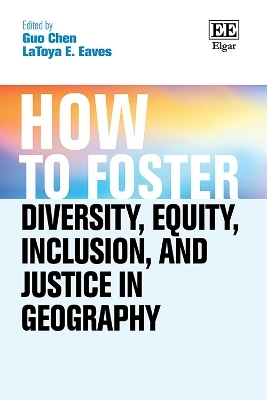
How to Foster Diversity, Equity, Inclusion, and Justice in Geography
Edward Elgar Publishing Ltd (Verlag)
978-1-0353-1075-3 (ISBN)
- Noch nicht erschienen (ca. Dezember 2024)
- Versandkostenfrei
- Auch auf Rechnung
- Artikel merken
Examining the foundations of why DEIJ matters in geography, this book engages readers in historical and empirical facts and a number of epistemic interventions from Black, Latinx, Indigenous and Asian-American geographies, as well as Women of Colour, queer, trans, and disabled geographers. It also provides theory-informed, yet hands-on guidance on how to foster DEIJ across academia, through geography unit leadership, school geography, graduate students, undergraduate teaching, and mentorship for safe and inclusive fieldwork. Ultimately, this book envisions the future of geographical knowledge-making with most recent examples about how to embrace DEIJ in a wide range of fields, including mapping and geographic information systems (GIS), physical geography and environmental science, radical geography, human geography, and urban geography.
How to Foster Diversity, Equity, Inclusion, and Justice in Geography is an important read for students, researchers and academics in all subdisciplines of geography, across human, environmental, and physical geography, regional geography, geographic methods, and geographical education, as well as those interested in feminist geography, decolonial and anti-racist geography, and critical geography approaches. The book is also beneficial to practitioners and policymakers aiming to foster DEIJ in higher education in the social sciences, natural sciences, arts and humanities.
Edited by Guo Chen, Associate Professor of Geography and Global Urban Studies, Department of Geography, Environment, and Spatial Sciences, Michigan State University and LaToya E. Eaves, Associate Professor of Geography, Department of Geography & Sustainability, University of Tennessee, US
Contents
1 How to foster diversity, equity, inclusion, and justice in geography: an introduction 1
Guo Chen and LaToya E. Eaves
2 Moving from theory to practice: operationalizing the American Association of Geographers’ Justice, Equity, Diversity, and Inclusion’s three-year strategic plan 17
Risha RaQuelle
PART I Understanding DEI and justice in geography
3 Racial and ethnic representations in geography and geosciences: cases of the United States and the United Kingdom 32
Demetrice R. Jordan and Munira Raji
4 Making space for ourselves: negotiating race, gender, and location in a white field 48
Anindita Datta
5 Black geographies 59
Khyree Davis, Suzanne Nimoh and Joshua Reason
6 Latinx geographies 73
Megan Ybarra and Lorena Muñoz
7 Indigenous geographies and the (un)reconcilability of academia? Challenges for making geography a more hospitable space for Indigenous scholars 81
Michael Fabris
8 Asian American geographies: from identity to epistemic justice 94
Laurel Mei-Singh, Wendy Cheng and Guo Chen
9 Internationalization and uneven global geographies of knowledge production and exchange in geography 114
Heike Jöns
10 Making space for queer and trans people in geography 130
Eden Kinkaid
11 (Dis)ability and geography 143
Jessica Martínez, Rose Shelor Moulton, Glen Norcliffe and John Radford
PART II Praxis and examples of fostering DEI and justice in geography
12 Using intersectionality and an ethos of care to advance belonging, accessibility, justice, equity, diversity, and inclusion at the unit-level 157
Emily Skop and Wei Li
13 Decolonial and anti-racist school geography in England 170
Steve Puttick
14 Voices and praxis from students: from doing feminist geographies in the global south to intersectional feminism in the global north 181
Maria Anne Fitzgerald, Rhianna Garrett and Prashanti Sharma
15 Centering social justice in teaching undergraduate geography 193
Meghan Cope
16 Intentional mentorship for safe and inclusive fieldwork 212
Akilah Alwan, Blair Schneider, Christopher Gentry and Erika Marín-Spiotta
PART III Future of DEI and justice in geography: new tools, methods, and directions
17 Evoking critical and creative forms of mapping/GIS for digital and health (in)equity 226
Jin-Kyu Jung
18 Toward inclusive fieldwork and communities of practice in physical geography and environmental science: experiences from the CULTIVATE team in the UK 239
Lynda Yorke, Elizabeth R. Hurrell and Simon M. Hutchinson
19 Cultivating solidarity and trust in the field through the “spiral model”: engaging with communities from a radical geographical perspective 252
Kayla Edgett and Nik Heynen
20 Everyone has a story: creative pathways to diversity, equity, inclusion, and justice in geography 263
Heather A. Davis and Derek Alderman
21 Embracing diversity, equity, inclusion, and justice in geography and empowering communities in the South Pacific: the example of Revitalising Informal Settlements and their Environments (RISE) in Suva, Fiji 275
Eberhard Weber, Andreas Kopf, Camari Koto, Catherine Musu Liolea, Ratu Tevita Rarokolutu and Sanjeshni Reddy
| Erscheint lt. Verlag | 28.12.2024 |
|---|---|
| Reihe/Serie | How To Guides |
| Verlagsort | Cheltenham |
| Sprache | englisch |
| Maße | 156 x 234 mm |
| Themenwelt | Naturwissenschaften ► Geowissenschaften ► Geografie / Kartografie |
| Sozialwissenschaften ► Pädagogik | |
| Sozialwissenschaften ► Soziologie | |
| ISBN-10 | 1-0353-1075-9 / 1035310759 |
| ISBN-13 | 978-1-0353-1075-3 / 9781035310753 |
| Zustand | Neuware |
| Haben Sie eine Frage zum Produkt? |
aus dem Bereich


